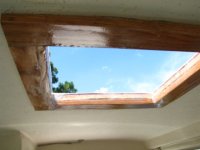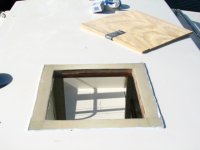SoBelle,
I did add more photos of the installation in my album.
The unit that was installed is a new model 9000 BTU Coleman, low profile (advertised as 8" height). The hole size requires a 14" to 15" square hole. You always want a radius corner in a boat, otherwise you will induce a crack over time. I drew a template on a piece of cardboard with radius corners that ended up being 14 1/2" wide. The hole was cut on the cabin top as far forward as the existing combination radar/searchlight mount allowed, to move weight as far forward as possible (I saved the cutout fiberglass, in case somewhere down the line the AC needs to be removed and the cabin put back to normal configuration).
The AC unit gasket is a hefty piece of dense foam, which had to be tapered to form to the curve of the cabin top. The AC unit comes with a steel backing plate that is bolted on from the interior and draws the outside unit down real tight and secure (no leaks).
The interior unit is prewired and plugs into the exterior unit. I did purchases the optional heater element and installed it as well. the system is also prewired and has hardware installed to mount the heater element without fuss.
Lastly, the AC unit requires a 15 amp fuse which was already preinstalled in my Paneltronics circuit panel. Installing the heater element requires a breaker of 20 amps, so I switched out the circuit breaker to 20 amps.
The interior unit would typically be mounted in a rooftop on an RV, where the headliner would hide the wires. In our case, there is no liner, so I drilled and sealed a hole on the interior of the unit to run the wiring forward.
As to impact on stability...no doubt adding 90 lbs to the top of anything floating does place weight where we know it should not be, but I did get underway last week in a blow (15 - 25 kts wind), just to see what the impact would be. Surprisingly, I could not feel any change in boat handing characteristics.
Everything in boating is a compromise and adding an AC unit was something I really did not want to do, but if my wife gets underway more often, then I'll do it as long as it does not jeopardize our safety in relatively normal conditions.
I do not plan to use the AC unit underway, so no, I do not plan on adding a generator. The air flow through the cabin is generally good even on hot days as long as you are underway with windows open. Once tied to the dock at the marina, that story changes, especially on a 90 degree day...


